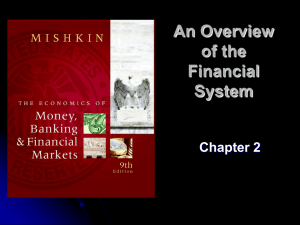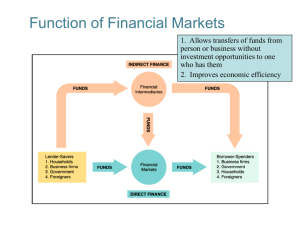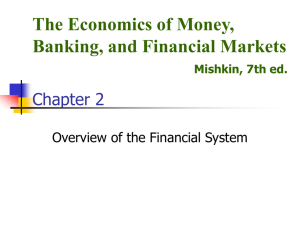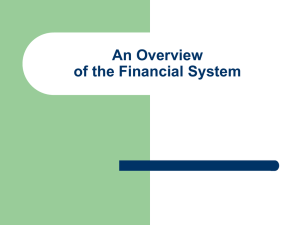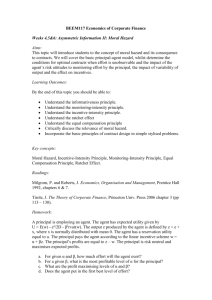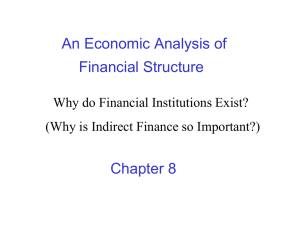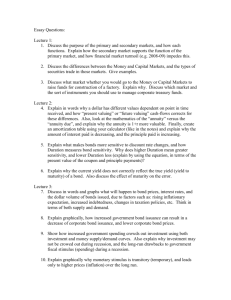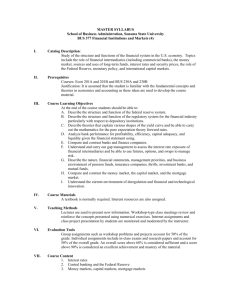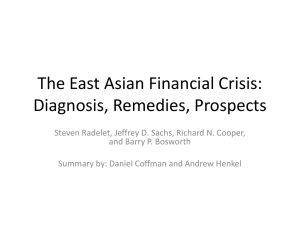An Overview of the Financial System
advertisement
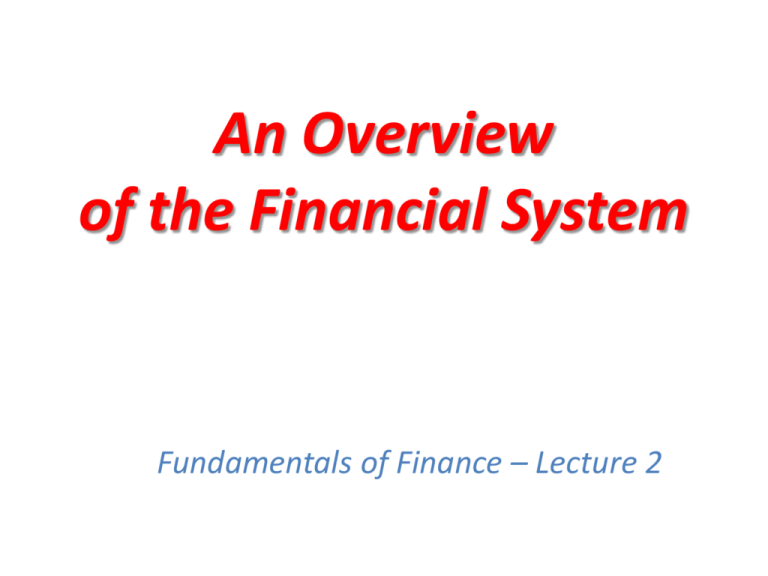
An Overview of the Financial System Fundamentals of Finance – Lecture 2 Outline of the lecture • • • • Financial Markets Financial Intermediaries Economic Analysis of Financial Structure Economic Analysis of Financial Regulation Financial Markets Function Structure Instruments Function of Financial Markets • Perform the essential function of channeling funds from economic players that have saved surplus funds to those that have a shortage of funds • Direct finance: borrowers borrow funds directly from lenders in financial markets by selling them securities • Promotes economic efficiency by producing an efficient allocation of capital, which increases production • Directly improve the well-being of consumers by allowing them to time purchases better Flows of Funds Through the Financial System Structure of Financial Markets • Debt and Equity Markets – Debt instruments (maturity) – Equities (dividends) • Primary and Secondary Markets – Investment Banks underwrite securities in primary markets – Brokers and dealers work in secondary markets Structure of Financial Markets (cont’d) • Exchanges and Over-the-Counter (OTC) Markets – Exchanges: NYSE, Sofia Stock exchange, etc. – OTC Markets: Foreign exchange, Federal funds • Money and Capital Markets – Money markets deal in short-term debt instruments – Capital markets deal in longer-term debt and equity instruments Internationalization of Financial Markets • Foreign Bonds: sold in a foreign country and denominated in that country’s currency • Eurobond: bond denominated in a currency other than that of the country in which it is sold • Eurocurrencies: foreign currencies deposited in banks outside the home country – Eurodollars: U.S. dollars deposited in foreign banks outside the U.S. or in foreign branches of U.S. banks • World Stock Markets – Also help finance the federal government Financial Markets Instruments Money market instruments – Treasury bills – Negotiable Banks Certificates of Deposits – Commercial papers – Repurchase agreements Financial Markets Instruments(cont’d) Capital Market Instruments – Stocks – Mortgages – Corporate bonds – Government securities – Local government bonds Financial Intermediaries Function of Financial Intermediaries: Indirect Finance • Lower transaction costs (time and money spent in carrying out financial transactions) – Economies of scale – Liquidity services • Reduce the exposure of investors to risk – Risk Sharing (Asset Transformation) – Diversification • Deal with asymmetric information problems – Adverse Selection: try to avoid selecting the risky borrower. • Gather information about potential borrower. – (after the transaction) Moral Hazard: ensure borrower will not engage in activities that will prevent him/her to repay the loan. • Sign a contract with restrictive covenants. Function of Financial Intermediaries: Indirect Finance (cont’d) • Conclusion: – Financial intermediaries allow “small” savers and borrowers to benefit from the existence of financial markets. Types of Financial intermediaries • Depository institutions – Commercial banks – Saving and loan associations and mutual saving banks – Credit unions Types of Financial intermediaries (cont’d) • Contractual Saving Institutions – Life Insurance Companies – Casualty Insurance Companies – Pension Funds Types of Financial intermediaries (cont’d) • Investment Intermediaries – Finance Companies – Mutual Funds – Money Market Mutual Funds – Investment Banks Regulation of the Financial System • To increase the information available to investors: – Reduce adverse selection and moral hazard problems – Reduce insider trading . • To ensure the soundness of financial intermediaries: – Restrictions on entry (chartering process). – Disclosure of information. – Restrictions on Assets and Activities (control holding of risky assets). – Deposit Insurance (avoid bank runs). – Limits on Competition (mostly in the past): • Branching • Restrictions on Interest Rates Economic Analysis of Financial Structure Basic Facts about Financial Structure Throughout the World How does the financial structure promote economic efficiency? • The bar chart in next slide shows how American businesses financed their activities using external funds (those obtained from outside the business itself) in the period 1970–2000 and compares U.S. data to those of Germany, Japan, and Canada Sources of External Funds for Nonfinancial Businesses: A Comparison of the United States with Germany, Japan, and Canada Eight Basic Facts 1. Stocks are not the most important sources of external financing for businesses 2. Issuing marketable debt and equity securities is not the primary way in which businesses finance their operations 3. Indirect finance is many times more important than direct finance 4. Financial intermediaries, particularly banks, are the most important source of external funds used to finance businesses. Eight Basic Facts (cont’d) 5. The financial system is among the most heavily regulated sectors of the economy 6. Only large, well-established corporations have easy access to securities markets to finance their activities 7. Collateral is a prevalent feature of debt contracts for both households and businesses. 8. Debt contracts are extremely complicated legal documents that place substantial restrictive covenants on borrowers Asymmetric Information: Adverse Selection and Moral Hazard • Adverse selection occurs before the transaction • Moral hazard arises after the transaction • Agency theory analyses how asymmetric information problems affect economic behavior The Lemons Problem: How Adverse Selection Influences Financial Structure • If quality cannot be assessed, the buyer is willing to pay at most a price that reflects the average quality • Sellers of good quality items will not want to sell at the price for average quality • The buyer will decide not to buy at all because all that is left in the market is poor quality items • This problem explains fact 2 and partially explains fact 1 Tools to Help Solve Adverse Selection Problems • Private production and sale of information – Free-rider problem • Government regulation to increase information – Not always works to solve the adverse selection problem, explains Fact 5. • Financial intermediation – Explains facts 3, 4, & 6. • Collateral and net worth – Explains fact 7. How Moral Hazard Affects the Choice Between Debt and Equity Contracts • Called the Principal-Agent Problem – Principal: less information (stockholder) – Agent: more information (manager) • Separation of ownership and control of the firm – Managers pursue personal benefits and power rather than the profitability of the fir Tools to Help Solve the Principal-Agent Problem • Monitoring (Costly State Verification) – Free-rider problem – Fact 1 • Government regulation to increase information – Fact 5 • Financial Intermediation – Fact 3 • Debt Contracts – Fact 1 How Moral Hazard Influences Financial Structure in Debt Markets • Borrowers have incentives to take on projects that are riskier than the lenders would like. – This prevents the borrower from paying back the loan. Tools to Help Solve Moral Hazard in Debt Contracts • Net worth and collateral – Incentive compatible • Monitoring and Enforcement of Restrictive Covenants – – – – Discourage undesirable behavior Encourage desirable behavior Keep collateral valuable Provide information • Financial Intermediation – Facts 3 & 4 Asymmetric Information Problems and Tools to Solve Them Asymmetric Information in Transition and Developing Countries • “Financial repression” (when governments channel funds to themselves as a form of debt reduction) created by an institutional environment characterized by: – Poor system of property rights (unable to use collateral efficiently) – Poor legal system (difficult for lenders to enforce restrictive covenants) – Weak accounting standards (less access to good information) – Government intervention through directed credit programs and state owned banks (less incentive to proper channel funds to its most productive use). Financial Development and Economic Growth • The financial systems in developing and transition countries face several difficulties that keep them from operating efficiently • In many developing countries, the system of property rights (the rule of law, constraints on government expropriation, absence of corruption) functions poorly, making it hard to use these two tools effectively Economic Analysis of Financial Regulation Asymmetric Information and Financial Regulation • Bank panics and the need for deposit insurance: – FDIC: short circuits bank failures and contagion effect. – Payoff method. – Purchase and assumption method (typically more costly for the FDIC). • Other form of government safety net: – Lending from the central bank to troubled institutions (lender of last resort). Government Safety Net • Moral Hazard – Depositors do not impose discipline of marketplace. – Financial institutions have an incentive to take on greater risk. • Adverse Selection – Risk-lovers find banking attractive. – Depositors have little reason to monitor financial institutions. Government Safety Net: “Too Big to Fail” • Government provides guarantees of repayment to large uninsured creditors of the largest financial institutions even when they are not entitled to this guarantee • Uses the purchase and assumption method • Increases moral hazard incentives for big banks Government Safety Net: Financial Consolidation • Larger and more complex financial organizations challenge regulation – Increased “too big to fail” problem – Extends safety net to new activities, increasing incentives for risk taking in these areas (as has occurred during the global financial crisis) Restrictions on Asset Holdings • Attempts to restrict financial institutions from too much risk taking – Bank regulations • Promote diversification • Prohibit holdings of common stock – Capital requirements • Minimum leverage ratio (for banks) • Basel Accord: risk-based capital requirements • Regulatory arbitrage Capital Requirements • Government-imposed capital requirements are another way of minimizing moral hazard at financial institutions • There are two forms: – The first type is based on the leverage ratio, the amount of capital divided by the bank’s total assets. To be classified as well capitalized, a bank’s leverage ratio must exceed 5%; a lower leverage ratio, especially one below 3%, triggers increased regulatory restrictions on the bank – The second type is risk-based capital requirements Financial Supervision: Chartering and Examination • Chartering (screening of proposals to open new financial institutions) to prevent adverse selection • Examinations (scheduled and unscheduled) to monitor capital requirements and restrictions on asset holding to prevent moral hazard – – – – – – Capital adequacy Asset quality Management Earnings Liquidity Sensitivity to market risk • Filing periodic ‘call reports’ Assessment of Risk Management • Greater emphasis on evaluating soundness of management processes for controlling risk • Trading Activities Manual of 1994 for risk management rating based on – – – – Quality of oversight provided Adequacy of policies and limits for all risky activities Quality of the risk measurement and monitoring systems Adequacy of internal controls • Interest-rate risk limits – Internal policies and procedures – Internal management and monitoring – Implementation of stress testing and Value-at risk (VAR) Disclosure Requirements • Requirements to adhere to standard accounting principles and to disclose wide range of information • The Basel 2 accord puts a particular emphasis on disclosure requirements • Mark-to-market (fair-value) accounting Macroprudential Vs. Microprudential Supervision • Before the global financial crisis, the regulatory authorities engaged in microprudential supervision, which is focused on the safety and soundness of individual financial institutions. • The global financial crisis has made it clear that there is a need for macroprudential supervision, which focuses on the safety and soundness of the financial system in the aggregate.
